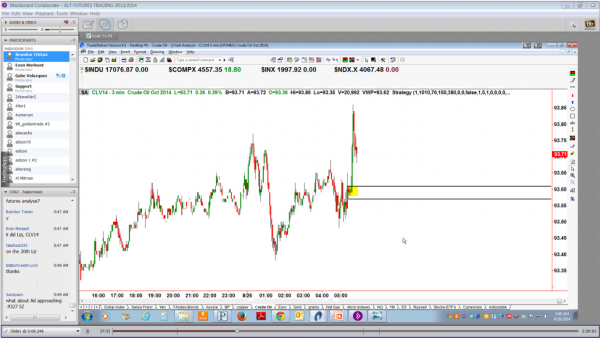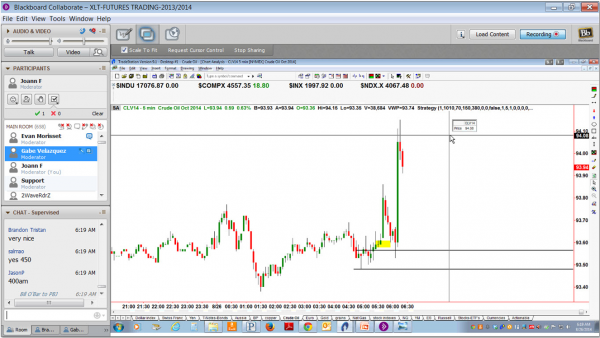![]()
So often in the trading world, I hear people talk about where price is likely to turn next, where is the next key supply or demand level, where is the next big market move going to originate from, and so on. The question I hardly ever hear anyone asking is, “Where is the next big profit zone?” This is one of if not the most important things to consider when speculating in markets.
The profit zone is the distance in price between the entry point and the profit target price. Another way to say that is the distance between demand and supply. When looking for trading opportunities, people tend to focus on where the next big turn in price will happen. As I often write about, these turns happen at price levels where supply and demand is out of balance. When looking at charts, you will find that there are many supply and demand levels. By no means are we interested in taking trading opportunities at all the levels we find. In fact, when considering profit zone into the filtering mix, we would ignore most of the supply and demand levels we find and narrow our focus down to the supply and demand levels that have large profit zones associated with them.
Live Trading & Analysis Room – Crude Oil Futures: 8/26/14 “The Setup”
To explain the concept of profit zone and its importance in trading, let’s take a look at a trade from last week from the Extended Learning Track (XLT), our live trading room at Online Trading Academy. Here we are looking at a small time frame chart of Crude Oil. Notice the demand level (yellow box). This is where we expected there to be more willing demand than supply. The strategy tells us that banks and institutions are buying Crude Oil Futures at that level. Next, notice the rally in price from that level. This tells us what our initial profit zone is and often, our entire profit zone. The fact that price rallied up to the high of that move tells us there can’t be any significant supply until that high or higher. So, when price declines back to our demand zone where we want to buy, we expect price not only to turn higher at demand but also rally to at least the high of that initial rally from demand. Again, that rally opens up the profit zone for us. In other words, there is no significant supply to stop price from rallying up to that high and higher, depending on where the fresh supply level is above that high. The trading opportunity was to buy at the demand level below and profit from a move higher.
The key element here is to identify where bank demand and supply is, then look at current price, and finally determine the “path of least resistance” as that is where the next move in price is likely to go. Meaning, price is likely to have a relatively easy time moving through the ranges between supply and demand, the profit zone. Keep in mind a VERY important point here: I am coming to all these conclusions BEFORE I enter the trade and making decisions based on objective information. You must perform your analysis in advance and make your decisions before its time to push the button or this will never work. This is exactly what we did in the XLT that morning, before prices moved into our action areas.
Live Trading & Analysis Room – Crude Oil Futures: 8/26/14 “The Result”
As you can see above, the trade worked out as planned and quickly traded much higher after turning at our demand zone. This is again because there was no significant supply above to stop price from doing this and we had all that information well in advance, since we knew what we were looking for.
As I mentioned earlier, there are many supply and demand levels on a chart and many large and small profit zones. The key for the astute trader is to be able to identify objective supply and demand levels. Then and only then will you be able to find supply and demand levels that have significant profit zones associated with them. What I do is ignore most supply and demand levels on a chart and only focus on the ones that have a great distance between them. This does two things. First, it obviously offers an attractive risk / reward opportunity. Second and just as important, the larger the profit zone, the greater the probability of the trade working out. This is because when you have a big profit zone, by definition your supply and demand levels are far out on the supply and demand curve. Entering your trades at market price extremes increases the probability of success.
To better understand the concept of profit zones in trading, think of profit margins in any other business. Think of how companies who sell products determine what to sell. Most of the decision if not all of it comes down to profit margin. Think about companies who produce products and how they decide what to produce. Most if not all of that decision comes down to profit margin. The decision on which trading opportunities to put your hard earned money at risk on is absolutely no different and in fact, we chart profit margin the same way as any successful company would.
Hope this was helpful. Have a great day.
Note: All information on this page is subject to change. The use of this website constitutes acceptance of our user agreement. Please read our privacy policy and legal disclaimer. Opinions expressed at FXstreet.com are those of the individual authors and do not necessarily represent the opinion of FXstreet.com or its management. Risk Disclosure: Trading foreign exchange on margin carries a high level of risk, and may not be suitable for all investors. The high degree of leverage can work against you as well as for you. Before deciding to invest in foreign exchange you should carefully consider your investment objectives, level of experience, and risk appetite. The possibility exists that you could sustain a loss of some or all of your initial investment and therefore you should not invest money that you cannot afford to lose. You should be aware of all the risks associated with foreign exchange trading, and seek advice from an independent financial advisor if you have any doubts.
Editors’ Picks
EUR/USD retreats toward 1.0650 after PMI-inspired rebound

EUR/USD loses traction and retreats to the 1.0650 area after rising toward 1.0700 with the immediate reaction to the upbeat PMI reports from the Eurozone and Germany. The cautious market stance helps the USD hold its ground ahead of US PMI data.
GBP/USD fluctuates near 1.2350 after UK PMIs

GBP/USD clings to small daily gains near 1.2350 in the European session on Tuesday. The data from the UK showed that the private sector continued to grow at an accelerating pace in April, helping Pound Sterling stay resilient against its rivals.
Gold flirts with $2,300 amid receding safe-haven demand

Gold (XAU/USD) remains under heavy selling pressure for the second straight day on Tuesday and languishes near its lowest level in over two weeks, around the $2,300 mark in the European session. Eyes on US PMI data.
Here’s why Ondo price hit new ATH amid bearish market outlook Premium

Ondo price shows no signs of slowing down after setting up an all-time high (ATH) at $1.05 on March 31. This development is likely to be followed by a correction and ATH but not necessarily in that order.
US S&P Global PMIs Preview: Economic expansion set to keep momentum in April

S&P Global Manufacturing PMI and Services PMI are both expected to come in at 52 in April’s flash estimate, highlighting an ongoing expansion in the private sector’s economic activity.
RECOMMENDED LESSONS
Making money in forex is easy if you know how the bankers trade!
Discover how to make money in forex is easy if you know how the bankers trade!
5 Forex News Events You Need To Know
In the fast moving world of currency markets, it is extremely important for new traders to know the list of important forex news...
Top 10 Chart Patterns Every Trader Should Know
Chart patterns are one of the most effective trading tools for a trader. They are pure price-action, and form on the basis of underlying buying and...
7 Ways to Avoid Forex Scams
The forex industry is recently seeing more and more scams. Here are 7 ways to avoid losing your money in such scams: Forex scams are becoming frequent. Michael Greenberg reports on luxurious expenses, including a submarine bought from the money taken from forex traders. Here’s another report of a forex fraud. So, how can we avoid falling in such forex scams?
What Are the 10 Fatal Mistakes Traders Make
Trading is exciting. Trading is hard. Trading is extremely hard. Some say that it takes more than 10,000 hours to master. Others believe that trading is the way to quick riches. They might be both wrong. What is important to know that no matter how experienced you are, mistakes will be part of the trading process.


